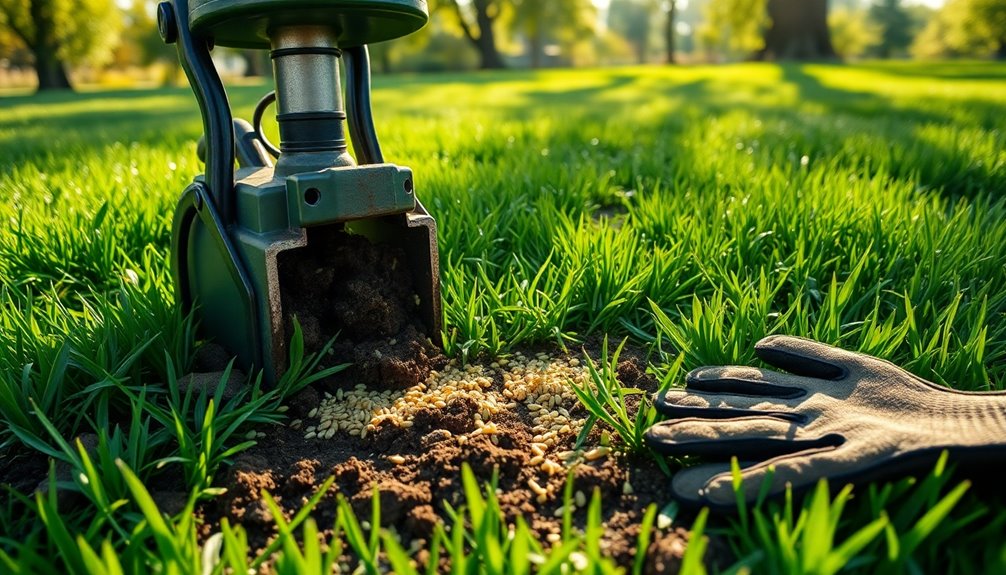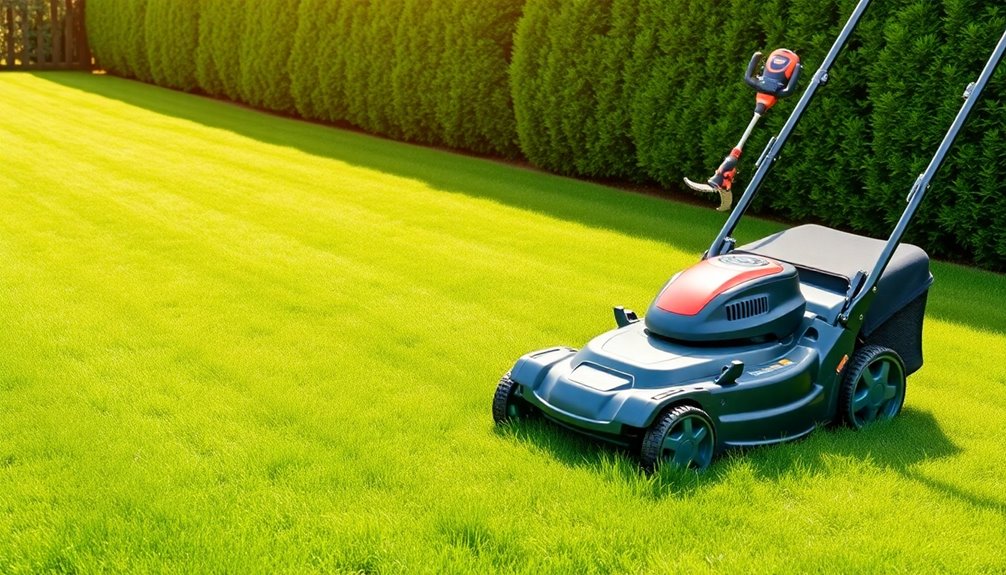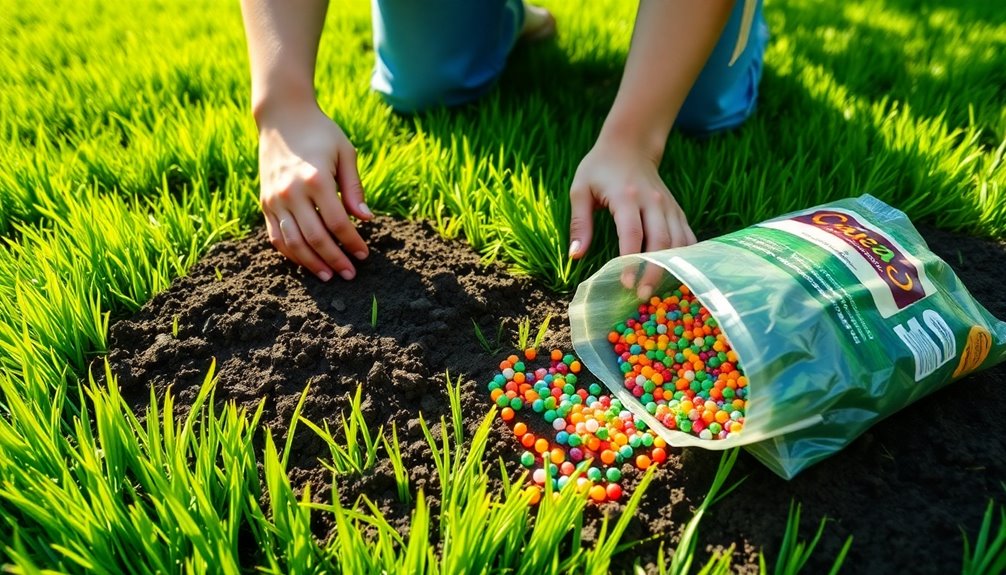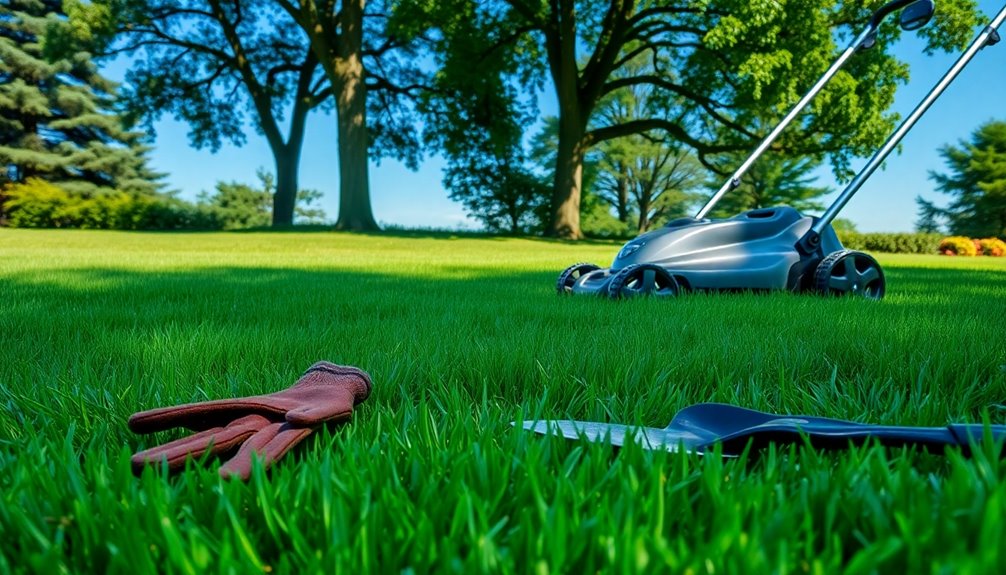To maintain your lawn like a pro, start with aeration and seeding to enhance soil health. Mow regularly, keeping grass at 2.5 to 3.5 inches to promote growth and reduce weeds. Water deeply but less frequently, preferably in the morning, to encourage strong roots. Test your soil and apply fertilizers based on its needs, avoiding over-fertilization. Hand-pull weeds promptly and use mulch to prevent their growth. Lastly, adjust your care routine seasonally to keep your lawn thriving all year round. Stick around, and you'll discover more expert tips to elevate your lawn care skills!
Key Takeaways
- Test your soil regularly to tailor fertilization and improve nutrient management for optimal grass health.
- Water deeply and infrequently, preferably in the morning, to encourage robust root growth.
- Mow at a height of 2.5 to 3.5 inches to maintain healthy grass and prevent weed growth.
- Use core aeration and overseeding techniques in the fall to enhance soil permeability and promote a lush lawn.
- Implement regular maintenance, including mowing, watering, and weed control, to ensure a thriving lawn year-round.
Aeration and Seeding Techniques

When you want to revitalize your lawn, understanding aeration and seeding techniques is crucial.
You can choose from spike aeration, which punctures the soil without removing it, or core aeration, the most effective method that pulls up small cores to improve drainage and oxygen absorption. Liquid aeration can also feed microbes and break down thatch non-invasively. Aeration is essential because it enhances soil permeability, allowing air, water, and nutrients to penetrate effectively.
Once your lawn's aerated, prepare for seeding by testing soil pH, clearing debris, and dethatching. Mark obstacles and compacted areas to avoid damage during aeration.
After aeration, overseed by spreading grass seed evenly and raking it into the soil. With proper watering, you'll set the stage for a lush, healthy lawn.
Effective Watering Practices

After aerating and seeding, effective watering practices play a vital role in establishing a healthy lawn. Start by measuring the water applied using collection devices, like tuna cans, to adjust your runtime.
Avoid daily watering; instead, aim for deep watering to encourage robust root growth. Water in the morning between 4 am and 10 am to reduce evaporation. Additionally, make sure to monitor moisture levels throughout different seasons, as roots vary in depth and require different attention.
Adjust your schedule based on soil and grass type, watering more frequently for sandy soils and cool-season grasses. Check your sprinkler system monthly for issues, and position sprinklers strategically to cover your lawn evenly.
Lastly, monitor moisture with a screwdriver to ensure you're reaching the depths needed for optimal growth. Remember, it's about watering deeply and infrequently!
Mowing and Trimming Strategies

To keep your lawn looking its best, mastering mowing and trimming strategies is essential.
Start by maintaining an optimal mowing height of 2.5 to 3.5 inches to promote healthy grass. Avoid scalping by never cutting more than one-third of the blade height.
Experiment with different mowing patterns like stripes, waves, diamonds, or circles to add visual interest while preventing soil compaction. Always mow dry grass with sharp blades for a clean cut, and don't forget to overlap rows to ensure even coverage. Stripes Mowing Pattern can enhance the overall aesthetics of your lawn by creating alternating light and dark stripes.
Regular maintenance of your mower is crucial for performance.
Soil Health and Fertilization

A beautiful lawn doesn't just come from regular mowing and trimming; it also relies heavily on soil health and proper fertilization.
Start by conducting soil testing to analyze pH levels and nutrient content, allowing you to tailor your nutrient management effectively. This helps avoid over-fertilization, minimizing the risk of polluting nearby water sources. Additionally, understanding specific soil types can guide you in making more informed amendments.
Incorporate compost into your soil for rich organic matter that boosts root growth and enhances overall health.
Aerate your lawn to ensure nutrients and air penetrate deeply, and water your grass efficiently—early morning is best.
Choose the right fertilizers based on your lawn's needs, whether synthetic, organic, or slow-release, and always follow the recommended application rates for optimal results.
Weed Control Methods

Weed control is essential for maintaining a healthy and vibrant lawn. Start by mowing regularly at a high blade setting to prevent weeds from germinating. Taller grass shades the soil, making it tougher for weeds to thrive. Regular mowing promotes healthy grass growth, which helps outcompete weeds.
Water your lawn deeply but infrequently to encourage deep root growth, which helps grass outcompete weeds. Pre-emergent herbicides are effective when applied 6-8 weeks before weeds are expected to sprout, creating a barrier in the soil.
For existing weeds, hand-pull them promptly, ensuring you remove the entire root to prevent regrowth. Using mulch around plants can also block weed growth by depriving them of light.
Combine these methods for optimal weed control and a healthier lawn.
Seasonal Maintenance Tips

Maintaining your lawn throughout the seasons is crucial for its health and appearance, especially as each season brings unique challenges and opportunities.
In spring, mow at the height specific to your grass type and water about 1 inch weekly. Test your soil and apply fungicides to ward off diseases. Additionally, apply pre-emergent herbicides to prevent weed germination during this time.
During summer, keep the grass at 2-3 inches, mow every 7-10 days, and water deeply but infrequently.
In fall, lower your mowing height slightly, overseed thin areas, and remove leaves to prevent disease.
Finally, in winter, reduce mowing and watering, and protect sensitive areas with frost cloth.
Regular maintenance will keep your lawn thriving year-round!
Frequently Asked Questions
What Are the Best Times of Year for Lawn Maintenance?
The best times for lawn maintenance vary by season.
In spring, you'll want to fertilize and overseed bare spots.
Summer requires deep watering and regular mowing.
Fall is crucial for fertilizing and aerating, while also reseeding thin areas.
During winter, sharpen your tools and apply winter fertilizer.
Each season has specific tasks that keep your lawn healthy and vibrant, so stay on top of these seasonal chores for optimal results.
How Can I Identify My Grass Type?
Did you know that there are over 12,000 grass species worldwide?
To identify your grass type, start by observing its color, texture, and growth pattern. Take note of the blade shape and any seed heads.
You can also use online databases or mobile apps for help. Engaging with gardening communities can provide valuable insights too.
Understanding whether your grass is a cool-season or warm-season type will further guide your identification process.
What Tools Are Essential for Lawn Maintenance?
For effective lawn maintenance, you'll need several essential tools.
Start with a reliable lawnmower and a string trimmer for those hard-to-reach areas. A leaf rake or blower helps clear debris, while an edger defines your lawn's borders.
Don't forget pruning shears and loppers for shaping your shrubs. For watering and fertilizing, a garden hose and a fertilizer spreader are crucial.
Having these tools ensures your lawn stays healthy and well-maintained.
How Often Should I Test My Soil?
You want a lush, vibrant lawn, but how can you achieve that if you don't know what's beneath the surface?
Test your soil every three years to keep track of its health. If you've got sandy soil, test it every two to three years.
After major changes or visible problems, it's crucial to check again.
Can I Use Homemade Fertilizers for My Lawn?
Yes, you can use homemade fertilizers for your lawn, but be cautious.
While they can be cost-effective and eco-friendly, their nutrient content often varies and mightn't provide what your grass needs. You risk burning your lawn if the concentration is too strong.
Always dilute your mixtures and monitor how your grass responds. Testing your soil beforehand helps ensure you're adding the right nutrients for optimal health and growth.
Conclusion
With a little dedication, your lawn can transform into a lush, green carpet that beckons bare feet. By mastering aeration, watering, and fertilization, you'll craft a vibrant oasis right in your backyard. Remember, consistency is key—treat your lawn with care, and it'll reward you with beauty and serenity. So roll up your sleeves, embrace the dirt, and watch your outdoor space flourish like a masterpiece in the hands of a skilled artist. Happy gardening!









